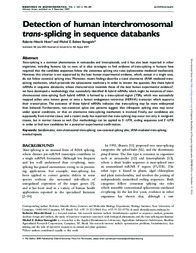Detection of human interchromosomal trans-splicing in sequence databanks.
Detection of human interchromosomal trans-splicing in sequence databanks.
Author(s): HERAI, R. H.; YAMAGISHI, M. E. B.
Summary: Trans-splicing is a common phenomenon in nematodes and kinetoplastids, and it has also been reported in other organisms, including humans. Up to now, all in silico strategies to find evidence of trans-splicing in humans have required that the candidate sequences follow the consensus splicing site rules (spliceosome-mediated mechanism). However, this criterion is not supported by the best human experimental evidence, which, except in a single case, do not follow canonical splicing sites. Moreover, recent findings describe a novel alternative tRNA mediated trans-splicing mechanism, which prescinds the spliceosome machinery. In order to answer the question, ?Are there hybrid mRNAs in sequence databanks, whose characteristics resemble those of the best human experimental evidence??, we have developed a methodology that successfully identified 16 hybrid mRNAs which might be instances of interchromosomal trans-splicing. Each hybrid mRNA is formed by a trans-spliced region (TSR), which was successfully mapped either onto known genes or onto a human endogenous retrovirus (HERV-K) transcript which supports their transcription. The existence of these hybrid mRNAs indicates that trans-splicing may be more widespread than believed. Furthermore, non-canonical splice site patterns suggest that infrequent splicing sites may occur under special conditions, or that an alternative trans-splicing mechanism is involved. Finally, our candidates are supposedly from normal tissue, and a recent study has reported that trans-splicing may occur not only in malignant tissues, but in normal tissues as well. Our methodology can be applied to 5'-UTR, coding sequences and 3'-UTR in order to find new candidates for a posteriori experimental confirmation.
Publication year: 2010
Types of publication: Journal article
Observation
Some of Embrapa's publications are published as ePub files. To read them, use or download one of the following free software options to your computer or mobile device. Android: Google Play Books; IOS: iBooks; Windows and Linux: Calibre.
Access other publications
Access the Agricultural Research Database (BDPA) to consult Embrapa's full library collection and records.
Visit Embrapa Bookstore to purchase books and other publications sold by Embrapa.

